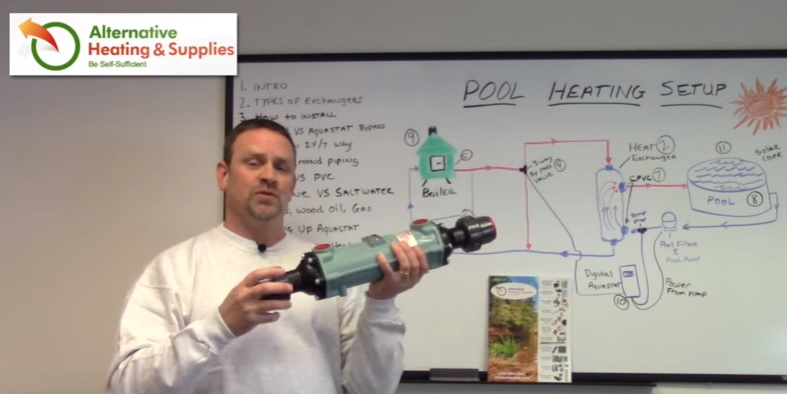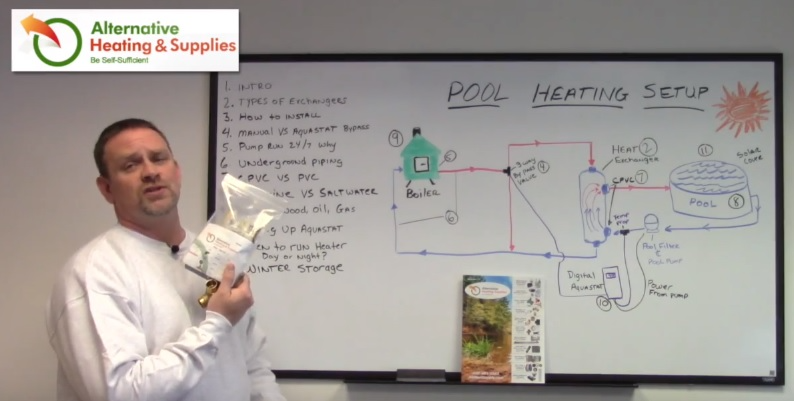How to Install and Set the Aquastat on a Swimming Pool Boiler
Posted by SEBASTIAN ZOTA
This is another Alternative Heating & Supplies episode on swimming pool setup and in this blog post we are going to talk about the installation kits and tips to set up the aquastat on a boiler to heat your swimming pool. Find out what are the best practices and how you can monitor the water temperature or heat it in extra season.
The Pool Heat Exchangers Installation Kit
Now we're gonna talk about the wiring of the aquastat. When you buy the kit from me, it already comes with a pre-wiring diagram. It is actually a very simple thing to do. But in the diagram that we provide you with our kits, it will explain it and show you a little picture of how to do it. But I'll give you a quick lowdown.
Quick Installation Tip
Basically, as I told you before in the early of the video, you wanna draw your power from the pool filter or the pool pump.
If you have 220, these run off at 110. Basically, the way 220 works is there is 2 legs of 110, which makes 220. You're just gonna pull off one of the legs.
Get a professional electrician to help you out with this. If you're not familiar with electricity, this is not where you wanna play. You get heat with the 220, it might be the last thing you do. Check that out. Get an electrician. So you gotta pull the 1 leg of 110 volts to your aquastat. That's gonna power the aquastat.
Examples and System Settings
You're gonna set the settings in which you like on the pool temperatures and the differential - let's say you set it to 189 like me and you want a 1-degree differential - it will ask you that in the settings. And then, if you set to 1, at 88 degrees it will turn on the heater again. Or, you can set a differential two. So at 87 degrees, it will turn on that thing to bring it back up to 89. You're gonna make that setting in the aquastat, whatever you choose. When that aquastat calls for heat, it's gonna open up this three-way valve.
When it's not calling for heat, the water is automatically gonna be bypassed, circulating this way.
When it calls for heat, it's gonna open this valve, which is going to, instead of sending the water down, it's gonna send it through the heat exchanger and back around. That's it. That's how simple this system is.
The Probe and Temperature Monitoring
What's gonna monitor the temperature of the water to tell it to turn off is the probe, which is mounted in the cold water line from the pool. We mount it on the cool side because we don't wanna monitor here because the water coming out of the heat exchanger is increased. So we monitor it here.

Temperature Monitoring
So after it's all circulated inside this pool and neutralizes, it will come through here and it will tell us to turn it off. Just that simple.
Wiring The Aquastat FAQs
When to Run the Heater?
One of the other common questions and some that took me months to learn is when to run your heater, day or night. Through trial and error, once again, finding out that if I ran the heater day and night, I thought I would get the greatest gain of heat, was most definitely wrong.
The most efficient way that I found heating the pool, and I've also done this with numerous other customers of mine, which I've explained to them that this worked for me, and they also agree with me that this was the best way to run their heaters also, is when you're running the pool, you're only running during daylight hours and you save some energy, so turn off the filters, turn off everything at night.
But the concept is, is that when you're running during the daylight and you're not swimming, and you put a solar cover on, which is a blanket basically, which is gonna hold the heat in at night, just like when you're sleeping at night, you put a blanket over your shoulders because your body is working less hard, which you wanna hold that heat in.
And then during the day, you keep the solar cover on and you circulate the water. So you're getting some solar benefit as well as heating benefit.
Obviously when you wanna swim in the pool, pull off the solar cover, go. You're ready to go swimming.
Why does the Pool Lose Heat During the Night?
When you close up at night, you wanna put that solar cover back on and turn off that filter. The reason why you lose so much heat at night is the heater is gonna be circulating the water through the heat exchanger.
And let's say we're running at night and you're going to the pool when you're making turbulence on water, turbulence on top of the water, that is a transfer of heat.
That is basically swapping the heat faster with the air outside, which is colder. So you will actually neutralize, and when I was doing it, I was gaining zero degrees at night and running my stove all night. So I made zero gain. When I found out that I turned off my heating system and covered my pool with a solar blanket, I also lost no temperature in the pool. So saved a lot of wood, saved a lot of electricity, and saved a lot of effort.
So turn this off at night. Put your solar cover on, and during daylight hours, keep your solar cover on, if you're not swimming, and turn on your filter, and you'll get that heat exchange. You'll gain anywhere, depending on heat exchanger which you choose, you can gain anywhere from 10 to 12 degrees a day.
So in the springtime, you open your pool and it's 55, 60 degrees, you could be 72, 75 degrees on the 1st day. During the 2nd and 3rd day you could be back up into the 80s and 90s, and you're ready to go swimming within a couple of days, depending on how big your stove is in the heat exchanger which you buy, and make sure it's installed properly. But that's the trick, you can get it.
And then once you've got the pool up the temperature, the maintaining of it uses much less wood, and the maintaining of the temperature of the pool is much easier for you, loading the stove. The first couple of days you will be cranking some wood and also oil or whatever heating system you're doing because you gotta heat up that many gallons of water and you're also heating up the ground around it.
So, don't be surprised that you're gonna go through some oil or wood, or natural gas and propane. Just like a conventional heating system or a pool heater.
How Much Does it Cost to Heat your Pool in Spring?
I have a friend that burned, I think, about $1,500 worth of propane to get his pool from spring or early spring temperatures, up to a temperature in which his kids could swim. This is gonna be a little more efficient, but it's still gonna be a big impact on the fuel consumption.
Winter Storage
Finally, putting the pool away, you're breaking down the filter, you're covering the pool, you've done your chlorination, you know, whatever you do to get your pool prepped and ready. You're gonna be breaking down your filter and everything like that in your pool pump, and most of us from New England here, everything freezes. These also freeze and will break. We recommend, like your pool filters, you usually have to break them down, drain them, and take them inside.
In this case with, again, the cupro-nickel heat exchanger, these always have unions on them. So when you're taking in your pool filter, you can break off the unions, take this inside just to prevent it from freezing.

Cupro Nickel Heat Exchanger
If there is water in here, even though this is a cast-iron exchanger on the outside, if there is water in here, it will freeze. If you don't wanna take it in, just make sure both lines, the boiler side, and the poolside, have no water in them, or very little.
Because if it's anywhere close to four, Mother Nature, with her freezing strength of water, will break anything.
The warranties on heat exchangers are incredibly good. There are 10 years on the cupronickel, and they're several years on the stainless steel. But there is nobody that covers freezing, so don't freeze them. Blow them out, dry them out, bring them inside, they'll last much longer.
Pool and Spa Kits
We also carry a full line of pool and spa kits to hook to these heat exchangers, whichever one you decide. The pool and spa kits that we sell have all the fittings, with the instructions of how to wire the aquastat, these things, and all the fittings that it does to tie into the packs. We have the three-way valves, as you can see here, the thermal wells for the aquastats, transformers and anything else you're gonna need to hook it up.

Installation Kits for Pool and Spa
However, the only parts that we do not include in these kits are the CPVC fittings. And the reason why is every pool will use a different size PVC, depending on the size of the pool.
Examples
For example, small, above ground pool will use a one-inch. A much larger, 44,000 gallon, 20 by 40 swimming pool in-ground will use anywhere from a 2 and a half to maybe a 2-inch pipe and so on, okay? There is too many variables for us to carry the CPVC, so we've decided that we're gonna leave that up to you, and everybody wants to plumb it differently.
Again, if you're using a stainless steel heat exchanger, we recommend you put unions here so you can take on and off in the winter. To put them warm, so they do not freeze. That's the only aspect of it, and that's really it.
Check out our yearly maintenance kits and do it yourself kits, and if you need assistance or you have questions that we did not cover here, give us a call!
